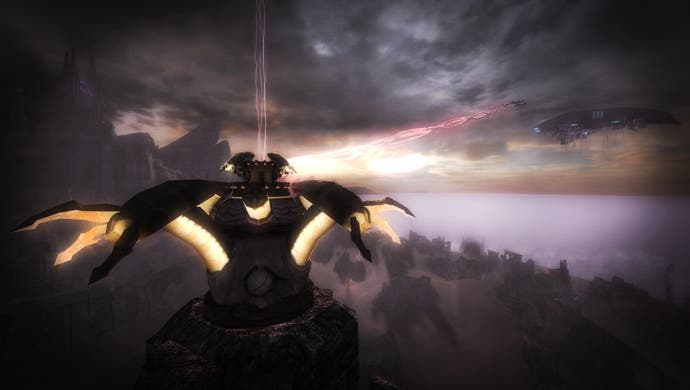Stormrise
"Faster than keyboard and mouse".
Creative Assembly PR Vispi Bhopti is a talkative bloke. He natters amicably throughout the two hour presentation for real-time strategy title Stormrise, dropping in anecdotes stories, technical details and expletives with ease. At one point, however, there's a pause. Bhopti scans the room to see if what he's just said has sunk in. He's just announced that Stormrise's Whip Select control system means using a control pad is even faster and more efficient than using a keyboard and mouse.
Having watched Bhopti zip around Stormrise's post-apocalyptic cityscapes with quick flicks of the right stick, it's something we're ready to believe. The system works like this: the camera settles naturally into a third-person view behind your current unit. Units and resource nodes are shown as white icons. Pressing the right stick produces a yellow beam. Direct that beam over one of white icons, let go and the camera will jump across the map to that point.
You can jump right from one side of the map to the other with one quick flick, or switch rapidly between all your units to keep track of events. In the PC version, holding right click and flicking the mouse will have exactly the same effect, which means less scrolling.
Initially, it all looks a bit bewildering. Identifying the small icons can be tricky and the rapid camera changes are disorientating. On top of that you need to have an awareness of where your units are on the map and how they relate to the camera position to navigate with accuracy.
We weren't allowed to go hands-on with the game, so we can only report that it all looks faster and more efficient than traditional control systems. However, speed and efficiency don't always equal ease of use, as so many developers who have produced console RTS games have discovered.

Originally, Stormrise wasn't meant to be a console title. In fact it was never meant to be a game at all. Whip Select was purely a conceptual idea, an answer to an engineering challenge which bored Creative Assembly statistician Ken Turner posed himself. But once the prototype was up and running, the idea was seen as having real potential. And Stormrise was born.
There were probably some other bits in-between, but that's the nub of it. They probably didn't spend a lot of time on the storyline, anyway. It's something to do with global warming and a weather control system which goes wrong and a giant storm which rips the world apart. Underground vaults are built just in time to host society's great and good, whilst the less fortunate are locked outside to fend for themselves.
This gives rise to the schism between Stormrise's two factions: the vault-dwelling, recently emerged Echelon and the surface-surviving, post-human Sai. It's a neat way of justifying the split between the Echelon's near-future technology and the Sai's more spiritual psychic powers and beast units, but we doubt it'll play a major part in most players' experience.
The two armies are relatively small, with only nine different units available to each commander: three each from the categories of infantry, mechs/beasts and air support. In addition, armies will be led by Hero units, tougher commanders with more customisation options. Lose your hero and it's all over. Heroes can be toughened up via the unusual research system, allowing access to body-part-specific items such as the fantastically named 'Twin Doom Capacitors'. This research system is an indication of how the game is as a whole appears to be moving away from the traditional aspects of the genre towards a more accessible, immediate take.

For a start, there's no unit research. Before each of the 12 single-player levels begins, the briefing screen will let you know which of your nine units are available. In multiplayer, the available troop types depend on the map. Unit upgrades occur individually and are purchased with combat experience. Creative Assembly sees the multiple upgrade paths available to heroes as a way of granting multiplayer armies a bit of individuality, and allowing players to hone their commander's skills to suit their playing style.
The resource aspect is also being pared-down. There's only one resource, in fact, and one simple node which can be built on command points. Nodes can be upgraded in various ways, usually so they improve the resource harvest or automated defences, but each one can only be set along one path. So, no bases either.
Units are called in at warp gates, another node upgrade option, and can be switched around your gates to relocate more expediently. The nodes also serve another purpose; once you own them they act like units, giving you another anchor point for the Whip Select system and allowing you to observe the immediate area.


